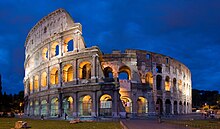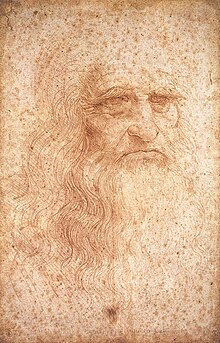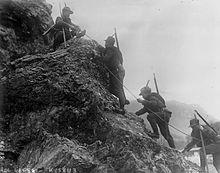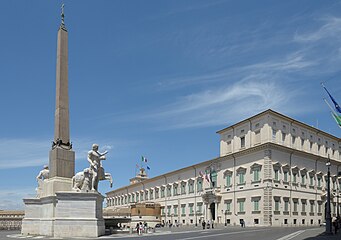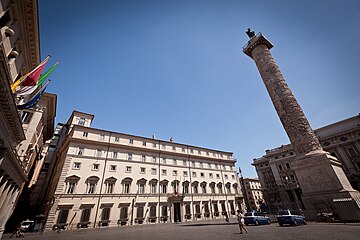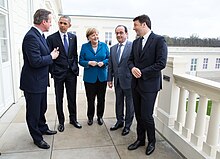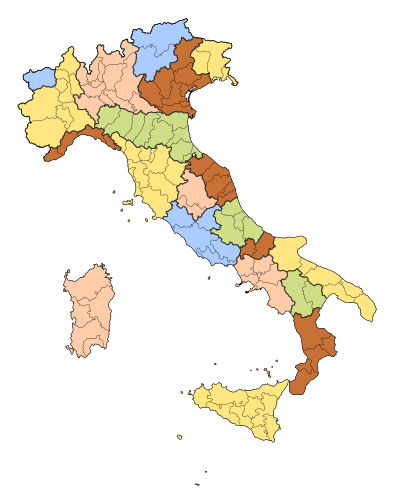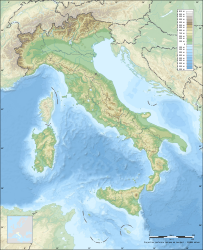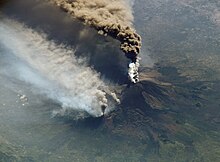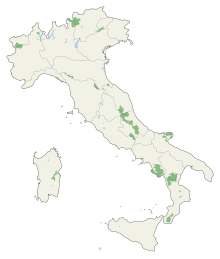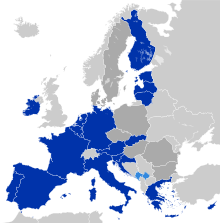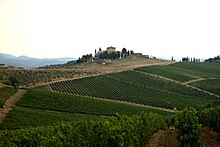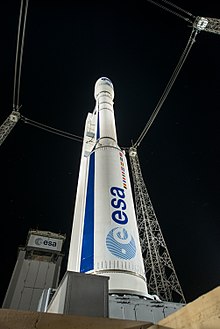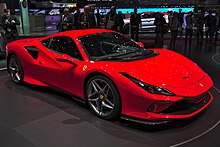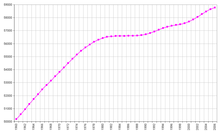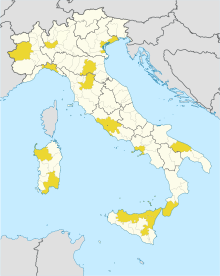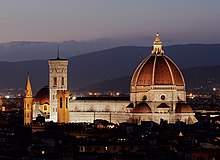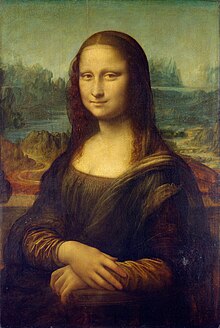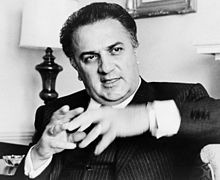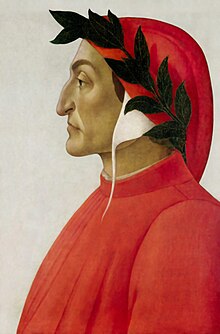Italy
Italy (in Italian, Italy, pronounced/i'talja/(![]() listen)), officially the Italian Republic (in Italian, Repubblica Italiana pronounced/re'pub:lika ita'ljana/), it is a sovereign transcontinental country, member and founder of the European Union, constituted in a parliamentary republic composed of twenty regions, these, in turn, by one hundred and eleven provinces.
listen)), officially the Italian Republic (in Italian, Repubblica Italiana pronounced/re'pub:lika ita'ljana/), it is a sovereign transcontinental country, member and founder of the European Union, constituted in a parliamentary republic composed of twenty regions, these, in turn, by one hundred and eleven provinces.
Italy is located in the center of the Mediterranean Sea, in southern Europe. It occupies the Italian peninsula as well as the Padana plain, the islands of Sicily and Sardinia and around eight hundred smaller islands, including the Tremiti islands in the Adriatic Sea, the Campano and Toscano archipelagos in the Tyrrhenian Sea, or the Pelagia islands. in North Africa, among others. In the north it is surrounded by the Alps and borders France, Switzerland, Austria and Slovenia. The micro-States of San Marino and Vatican City are enclaves within Italian territory; in turn, Campione d'Italia, is a municipality that forms a small Italian exclave on Swiss territory.
Due to its central location in the Mediterranean Sea, Italy received, during antiquity, various influences from external Mediterranean civilizations, such as the Phoenicians and Carthaginians on its major islands and the ancient Greeks on the so-called Magna Graecia, as well as being the home of many different cultures of its own, such as the Nuragic civilization, the Etruscans and the Latins, the latter being the ones who gave life to the Roman civilization, and attended the birth of the Republic and the later Roman Empire. After the fall of the Western Roman Empire, the Byzantines, Lombards and Muslims disputed control over the Italian territory, thus breaking their previous political unity. From the High Middle Ages, Italy was the cradle of maritime republics such as Venice, Genoa, Pisa and Amalfi, of the Papal States and also of humanism, the Renaissance and the baroque movement, among other States and cultural movements. In the c During the XIX century, through the historical process known as Risorgimento, the various Italian territories managed to unify under one State: the Kingdom of Italy.
The capital of Italy, Rome, has been the political and cultural center of Western civilization for centuries. In addition, it is the holy city for the Catholic Church, the Pope being the Bishop of Rome and the micro-State of the Vatican being found within the city. The cultural significance of the country is reflected in all its World Heritage Sites, since it has 58, the country with the largest number in the world.
It is the third country in Europe that receives the most tourists per year, being Rome the third most visited city on the continent. Other important cities are: Milan, center of finance and industry, and, according to the Global Language Monitor, the capital of Fashion; Naples, an important port on the Mediterranean, historical capital and most populous city of the Mezzogiorno; Turin, center of the automobile industry and industrial design. Italy is a democratic republic, it is part of the G7 or group of the seven largest advanced nations in the world and it is a developed country with a very high quality of life, being in 2005 among the top seven in the world.
It is the country number 28 (2017 report) in terms of high human development index. It is a regional and world power, a founding member of the European Union, signatory of the Treaty of Rome in 1957. It is also founding member of the North Atlantic Treaty Organization (NATO) and member of NATO Quint, the Organization for Economic Cooperation and Development, the World Trade Organization, the Council of Europe, the G-4, the G- 12 and the G20. The country, and especially its capital, has a strong impact on political and cultural issues, in world organizations such as the Food and Agriculture Organization (FAO), the International Fund for Agricultural Development (IFAD), the Glocal Forum or the World Food Program (WFP).
Etymology
The name Italy has been in use since ancient times, at least since the 8th century a. C., initially to designate the southern regions, and later also the central ones, of what is known as the Italic peninsula, referring to the Italic peoples, speakers of the languages also called.
According to the Greek historian Antiochus of Syracuse, the word Italy designated, before the century V a. C., to the southern part of the current Italian region of Calabria —the old Brucio—, inhabited by the itàlii, the southernmost group of the Italics (currently this area includes the Calabrian provinces of Reggio, Vibo Valentia and parts of the province of Catanzaro). It is possible that the Italics took their name from an animal-totem, the calf, which, in a distant sacred spring, had guided them to the places where they settled permanently.. Also, according to the archaeologist Pallottino, the name Italia would derive from the adjective of one of the native Italic peoples of the Calabria region, the (v)itàlii, which shared its name of his sacred animal: the calf (viteliú in the Oscan language, vitulus in Latin and vitello in Italian); and that it was used by the ancient Greeks as a general term to designate the inhabitants of the entire peninsula.
In the II century B.C. C., the Greek historiographer Polybius called Italy the territory between the Strait of Messina and the northern Apennines, although his contemporary Cato the Elder extended the territorial concept of Italy to the Alpine arc. The term was definitively consolidated, especially since the Italic city of Rome, from the V century B.C. C., gradually unified the entire peninsula conquering and federating the rest of the peninsular Italic peoples, beginning with the Latins, of which it constituted a village, and ending with the Etruscans to the north and the Brutians to the south, thus unifying all the peninsular territory under a single regime and giving it the name Italy, which, since then, will constitute the metropolitan territory of Rome itself.
The name Italy was also used on coins minted during the Social War by the coalition of Italian socii (allies), fighting against Rome and the other cities Italics already provided with Roman citizenship, to obtain, in turn, full Roman citizenship, which was granted after the Social War to all free inhabitants of Italy through the Lex Plautia Papiria. Later, northern Italy (former Cisalpine Gaul), was officially added to the territory of Roman Italy in the course of the I century B.C. C., thus taking, de iure , the name of Italy to the foot of the Alps; meanwhile, the islands of Sicily, Sardinia and Corsica, will not become part of Italy until the III d. C., as a consequence of Diocletian's administrative reforms, although their close cultural ties with the peninsula allow them to be considered as an integral part.
History
Early cultures and the Iron Age
Between the 17th century B.C. C. and the II century B.C. C. existed in Sardinia the Nuragic culture. During the Iron Age, several cultures followed one another that can be differentiated into four large main geographical nuclei: the Oscos, settled along the entire Apennine mountain range (and belonging to the macro-group of Italic peoples known as Osco-Umbrians), the Latins of the Latium Vetus (Italic people of the Latino-Faliscan group), the Italiots of Magna Graecia and the pre-Indo-European people of the Etruscans, in Etruria. Another culture, differentiated from those already mentioned, that of the Ligurians, was an enigmatic pre-Indo-European people who lived in northwestern Italy.
The Etruscans were a pre-Indo-European speaking people whose historical center was Tuscany, to which they gave their name: they were called Τυρσηνοί (tyrsenoi) or Τυρρηνοί (tyrrhenoi) by the Greeks, and tuscii or later etruscii by the Romans; they called themselves rasena or rašna. For a long time the origins of the Etruscans were believed to be unknown, however, modern research on the origin of the Etruscans, carried out by a group of geneticists and coordinated by Guido Barbujani, a member of the Department of Biology and Evolution at the University of Ferrara, came to the conclusion that, genetically, the origin of the Etruscans is autochthonous to the Italian peninsula, and that it would consist of an evolution of the previous Villanovian civilization.
From Tuscany they spread south towards Lazio and the northern part of Campania, where they collided with the Italian polis of Magna Graecia (southern Italy); while to the north of the Italian peninsula they occupied the area around the valley of the river Po, to the south of the current region of Lombardy. They became a great naval power in the western Mediterranean, which allowed them to establish factories in Sardinia and Corsica. However, around the V century B.C. C. its power began to deteriorate strongly, to a large extent by having to face, almost at the same time, the invasions of the Celts, from the north, and the competition of the Carthaginians for maritime trade, from the south. From the IV century BC. C., Etruria (name of the territory of the Etruscans), was gradually conquered and absorbed by the Roman Republic and, the Etruscans, like the other Italics, federated by the Romans, thus becoming an integral part of Roman Italy.
Ancient Rome
Ancient Rome refers to an agricultural society that emerged in the middle of the VIII century a. C. in Latium Vetus (present-day Lazio), which expanded from the city of Rome to the entire Italian peninsula, unifying it under the name of Italy, and which grew during centuries until it became an empire that, in its heyday, reached from the Iberian Peninsula to Anatolia and from the British Isles to Egypt, causing an important cultural flowering in each place where it ruled. Initially, after its foundation (according to tradition in 753 BC), Rome was an Etruscan monarchy, later (509 BC) it became a Latin Roman Republic and, in 27 BC. C., became an empire.
The period of greatest splendor is known as the Roman Peace, due to the relative state of harmony that prevailed in the provinces (the territories conquered by the Romans outside of Italy, which was not a province, but the metropolitan territory of Rome itself and the absolute center of the Roman Empire), which were under the Roman rule of Julius Caesar and then Emperor Augustus, who closed the doors of the Temple of Janus (which remained open during periods of war) when he believed he had defeated the Cantabrians and Astures, among other towns, in the year 24 B.C. C.. It is usually accepted as the start date of the Roman Peace (or Pax Augustea) 29 B.C. C., when Augusto declares the end of the civil wars, and their duration until the death of Marco Aurelio (year 180).
With Emperor Diocletian the empire was reorganized, but after Constantine I it was not unified again since Theodosius I divided it between his two sons, Arcadius and Flavio Honorius, awarding one of them the Eastern Roman Empire —based in Constantinople — and on the other the Western Roman Empire. The barbarian invasions will put an end to the Western Empire in 476, giving way to the Middle Ages. Italy in this period was left as Regnum Italiae (Ostrogothic Kingdom of Italy), under the Ostrogoths.
Middle Ages (5th to 13th centuries)
The Ostrogoths were a group of Goths who had been subjugated by the Huns, but after their liberation from the Huns, Theodoric the Great, with the blessing of the Eastern Roman Emperor, led his people to Rome in 488. The Italian peninsula was ruled by the Herulian Odoacer, after deposing the last Western Roman Emperor, Romulus Augustulus, in 476, but after a campaign in the north of the peninsula, Theodoric took the capital, Ravenna, killing Odoacer in 493. In 526 the death de Teodorico ended peace, inheriting Italy his grandson, Atalaric, who died childless, which produced a crisis that led to the disappearance of the kingdom.
Under Justinian I, the Eastern Roman Empire began a series of campaigns with the aim of rebuilding Mediterranean unity. The weakness of the Ostrogothic kingdom, and the Empire's desire to recapture Rome, made Italy a target. In 535 the general Belisarius invaded Sicily and marched across the peninsula, taking Naples and reaching Rome in 536. He proceeded north and took Mediolanum (Milan) and Ravenna in 540, and by 561 had pacified the area.
Among the different Germanic peoples who had abandoned their former home to live in better lands, there were the Lombards, whom Justinian I had allowed to settle in Pannonia, on condition that they defended the border, and who later went to towards Italy. The invasion of the Lombards reduced the Byzantine presence to the rump kingdom of the Exarchate of Ravenna and marked the end of the political unity of the peninsula for the next 1,300 years. Thus, the peninsula was divided as follows: northern Italy and Tuscany formed the Lombard kingdom, with its capital at Pavia, while in south-central Italy the Lombards controlled the duchies of Spoleto and Benevento. The rest of the peninsula remained under the Byzantines and was divided between the Exarchate of Italy, based in Ravenna, the Duchy of Rome, the Duchy of Naples, the Duchy of Calabria, and Sicily, the latter directly dependent on the Emperor of Constantinople. The pressure of the Lombards on the Pope caused the King of the Franks, Pepin the Short, to carry out, between 756 and 758, repeated campaigns in northern Italy. The situation escalated after Pepin's death, but the reunification of the Franks under Charlemagne led to a new intervention in Italy in 774. After a brief battle, Charlemagne seized the Lombard Kingdom of Italy, which, while maintaining its autonomy, became integrated into the Carolingian Empire.
Between the centuries X and XIII, the Italian maritime republics enjoyed great economic prosperity, thanks to their commercial activity, within a framework of broad political autonomy. Generally, the definition refers in particular to four cities and their respective republican territories: Amalfi, Genoa, Pisa and Venice. Other cities in the area also enjoyed independence (autonomous government in the form of an oligarchic republic, their own currency, army, etc.), they had participated in the crusades, they had a naval fleet, they had fundagos, consuls who watched over the commercial interests of their respective countries. States in the Mediterranean ports, and can be included by operation of law among the Italian maritime republics. Among these, Ancona, Gaeta and Noli should be highlighted.
Modern Age
During the 14th and XV, northern Italy was made up of different city-states, the rest of the peninsula being occupied mostly by the Papal States and the Kingdom of Naples (peninsular partition of the previous Kingdom of Sicily). Most of the city-states were subordinated to foreign sovereignties, such as the Duchy of Milan, a constituent state of the Holy Roman Empire, however the majority maintained the de facto independence of these foreign sovereignties, which had ruled a good part of the peninsula since the Fall of the Western Roman Empire.
The strongest of these city-states gradually absorbed the surrounding territories, giving rise to the Signorie, regional states led by merchant families who founded local dynasties. Warfare between these city-states was customary and mainly carried out by bands of mercenaries led by Italian captains known as condottieri. Decades of fighting left as regional powers the republics of Florence and Venice and the Duchy of Milan, who signed the Treaty of Lodi in 1454, which brought peace to the region for the first time in centuries. The peace would last for the next forty years.
The European Renaissance was a period of revival in the arts and sciences originating in Italy thanks to several factors, such as the great wealth accumulated by Italian cities, the patronage of ruling families such as the Medici in Florence, and the migration of Byzantine scholars due to the conquest of Constantinople by the Ottoman Empire. The Renaissance ended in the mid-16th century century due to events resulting from the Italian Wars. The ideas and ideals of the Italian Renaissance spread throughout Northern Europe, France, England, and the rest of Europe.
During the Italian Wars (1494-1559), caused by the rivalry between the Kingdom of France and the Spanish Monarchy, several Italian states gradually lost their political independence, being governed first by the Habsburgs of Spain (1559-1713) and later by the Austrian Habsburgs (1713-1796). Between 1629-1631 a strong plague, consisting of a series of bubonic plague outbreaks, wiped out 14% of the population. The decline of the Spanish Empire in the 17th century took with it the kingdoms of Naples, Sicily, Sardinia and the Duchy of Milan. In the 18th century, due to the War of the Spanish Succession, Austria replaced Spain as the main foreign power. During the Napoleonic Wars, northern Italy was reorganized as the Kingdom of Italy (1805-1814), a puppet state of the First French Empire, while the south was ruled by Joachim Murat, Napoleon's brother-in-law, crowned King of Naples. In 1814 the Congress of Vienna restored the situation of the 18th century century, although the ideals of the French Revolution were not eradicated.
Unification and Kingdom
The birth of the Kingdom of Italy was thanks to the united efforts of nationalists and monarchists loyal to the House of Savoy, to establish a unified state on the Italian peninsula. In the context of the liberal revolutions of 1848 that swept through Europe, there was an unsuccessful first war of independence against the Austrian Empire. The Kingdom of Piedmont-Sardinia attacked Austria again in the second Italian war of independence in 1859, with the help of France, resulting in the liberation of Lombardy.
In 1860-61, General Giuseppe Garibaldi carried out the Unification in the Kingdom of the Two Sicilies, causing the Count of Cavour to declare a unified Kingdom of Italy on March 17, 1861. In 1866, Victor Emmanuel II it allied with Prussia during the Austro-Prussian war, in the third Italian war of independence that allowed the annexation of Veneto. Finally, after the Franco-Prussian War of 1870, France abandoned her interest in Rome, which allowed for the capture of Rome and the end of the Papal States.
The Albertine Statute of 1848 was extended to the entire Kingdom of Italy in 1871, providing it with basic liberties, although electoral laws excluded the propertyless and the uneducated. The new government of the kingdom was a constitutional parliamentary monarchy, dominated by liberal forces. Universal male suffrage was adopted in 1913. While the North industrialized rapidly, the South and rural areas of the North remained underdeveloped and overcrowded, forcing millions of people to emigrate. The Italian Socialist Party was strengthening and challenging the traditional liberal and conservative parties. From the late 19th century century, Italy became a colonial force, with colonies in Somalia, Eritrea, Libya and the Dodecanese.
In June 1914, Red Week in Ancona was marked by bloody clashes between the police and workers after an anti-militarist demonstration. A strike of 50,000 metalworkers was called (in which two workers were killed by soldiers) and the whole of northern Italy was swept by a wave of agitation that mobilized 100,000 soldiers against it.
Italy, an ally of the German and Austro-Hungarian Empires in the Triple Alliance, in 1915 joined the Allied forces in World War I, with the promise of expanding its territory, with the lands of Inner Carniola, the Austrian Littoral and Dalmatia. The Italian army was initially bogged down in trench warfare in the Alps. In October 1918, the Italians launched a ferocious offensive that culminated in victory at the Battle of Vittorio Veneto. The victory ensured the end of the war on the Italian front. Two weeks later the conflict ended.
During the war, 650,000 soldiers and many civilians died, bankrupting the kingdom. The treaties of Saint Germain, Rapallo and Rome, granted most of the claimed territories, but not the Dalmatian coast, which led various nationalist groups to define the victory as mutilated. Later, after the creation of the Free State of Fiume by the poet Gabriele D'Annunzio, Fiume was also annexed.
Fascist dictatorship
The socialist upheavals that followed World War I, inspired by the Russian Revolution, led to counterrevolution and repression. Due to the fear of a revolution, the small National Fascist Party, led by Benito Mussolini, became a major political force. In October 1922, the black shirts of the PNF carried out a coup attempt (the March on Rome), which failed at the last moment, despite this King Victor Emmanuel III refused to declare a state of siege and converted Mussolini as prime minister. In the following years, Mussolini eliminated all political parties and personal liberties, establishing a fascist dictatorship. These actions inspired the rise of other similar dictatorships in Europe, such as Nazi Germany or Franco's Spain.
In 1935, Italy invaded Ethiopia in the Second Italo-Ethiopian War, leading to the country's withdrawal from the League of Nations. Italy allied with Nazi Germany, the Empire of Japan, and supported Francisco Franco in the Spanish Civil War. In 1939 Fascist Italy annexed Albania, already a de facto Italian protectorate for decades. Italy entered World War II on June 10, 1940. After initially advancing into British Somaliland and Egypt, it was defeated in North Africa, Greece, and the Eastern Front.
After the attack on Yugoslavia by Nazi Germany and Fascist Italy, strong pressure on the partisan resistance and attempts to Italianize the Slavs resulted in Italian war crimes and the deportation of 25,000 people to camps rally. About 250,000 anti-communist Italians and Slavs left the country in the Istrian exodus.
The first open resistance occurred in March 1943, when a wave of strikes, beginning in Turin, spread, despite arrests, throughout northern Italy, involving 100,000 workers. Its immediate cause was the immense material difficulties caused by rising prices and bombing. But several communist activists were at the forefront of the agitation and hoped to undermine the fascist regime.
The Allied invasion of Sicily began in July 1943, leading to the collapse of the regime on July 25. On September 8 there was the Armistice between Italy and the allied armed forces. The Germans quickly took power over the center and south of the territory. The country remained a battlefield for the remainder of the war, as the Allies slowly advanced out of the south.
To counter the Allied advance, the Italian Social Republic was created, a Nazi puppet state, with Mussolini at its head. The countrymen organized a resistance movement against Nazism and fascism. Faced with the advance of the allied armies and partisan groups, the fascist regime faced a growing resistance movement in the factories, with a great strike in Genoa in January 1944 after the execution of political prisoners, and another strike of 300,000 workers. in Milan in March, which extends to Veneto, Bologna and Florence. German forces responded with mass arrests and deportations. Hostilities ended on April 29, 1945, when the resistance defeated the Nazis, forcing them to leave the country. Mussolini was shot. Almost a million Italians (including civilians) died in the war and the national economy was totally destroyed.
Republic
Italy became a republic after a plebiscite held on June 2, 1946. On this occasion, for the first time, women were able to vote. Humberto II was forced to abdicate and go into exile. The Republican Constitution was approved on January 1, 1948. Most of Venice Julia was lost to Yugoslavia, and the Free Territory of Trieste was divided between the two states. All colonial possessions were lost, ending the Italian Empire.
Fear of the triumph of communism was crucial in the country's first election, in April 1948, which gave victory to the Christian Democrats, under the leadership of Alcide De Gásperi. Consequently, in 1949, Italy joined NATO. The Marshall Plan helped revive the national economy, which, until the late 1960s, experienced a boom period known as the economic miracle. In 1957 it was a founding member of the European Economic Community (EEC) which, in 1993, became the European Union (EU).
From the end of the 1960s to the end of the 1980s, we lived through the years of lead (anni di piombo), characterized by the economic crisis (especially the oil crisis of 1973), social conflicts and terrorist attacks by extreme opposition groups, due to the Cold War and the meddling of US and Soviet intelligence. The era culminated in the assassination of Christian Democrat leader Aldo Moro in 1978 and the massacre at the train station of Bologna in 1980, leaving 85 dead.
In the 1980s, the hegemony of the Christian Democrats was broken, with a liberal government (Giovanni Spadolini in 1981) and a socialist one (Bettino Craxi in 1983), but the Christian Democrats continued to be the main party. During the Craxi government the economy recovered, becoming the fifth most industrialized nation in the world, being part of the G7. But, due to government spending, the debt skyrocketed, reaching 100% of GDP.
The 1992 elections were characterized by the failure of the major parties, a product of political paralysis, excessive debt, and the corruption of the electoral system, revealed by the Manos Limpias investigation, requiring radical changes. Scandals involved most of the parties, but especially the ruling party: the Christian Democrats, who had ruled for more than fifty years, suffered a strong crisis and disintegrated into various factions. The communists reorganized as a social democratic force. In 1993 there were various resignations, including those of the then prime minister and Bettino Craxi. During the 1990s and 2000s, the center-right coalition (led by media mogul Silvio Berlusconi) and center-left coalitions (led by university professor Romano Prodi) alternated governing the country.
In 2008 the country fell victim to the recession. Until 2015, it suffered 42 months of economic recession. The economic crisis was one of the main factors that made Berlusconi resign in 2011. In 2012 the Costa Concordia accident occurred, a semi-sunk cruise ship with 32 deaths. In the 2013 general election, the Secretary General of the Democratic Party, Enrico Letta, formed a new government at the head of the Grand Coalition. In 2014, challenged by the new secretary of the PD, Matteo Renzi, he resigned and was replaced by himself. He undertook important constitutional reforms such as the abolition of the Senate and a new electoral law. On December 4, the constitutional referendum was rejected, leading to Renzi's resignation 12 days later. The foreign minister, Paolo Gentiloni, was appointed as the new prime minister.
Italy was affected by the European migration crisis in 2015 as it became the entry point and main destination for most asylum seekers in the European Union. The country received over half a million refugees, causing great revulsion among the population and a rise towards the support of the far-right and Eurosceptic parties, based on Brexit, which led to the first anti-establishment government of the European Union, in 2018.
Government and politics
The policy is based on a parliamentary republican system with representative democracy since June 2, 1946, when the monarchy was abolished by popular referendum. Executive power rests with the Council of Ministers, headed by the head of government (Presidente del Consiglio dei Ministri), informally called the Prime Minister, one of the five most important positions in the country along with the President of the Republic, President of the Senate of the Republic, President of the Chamber of Deputies and President of the Constitutional Court.
Legislative power is vested in Parliament and the Council of Ministers. The judiciary is independent of the executive and the legislature. Also, it is a multi-party system. In the south of the peninsula and on the island of Sicily, the mafia has as much or more power than the State, even controlling newspapers, judges and police. In 1992, the assassination of Giovanni Falcone, a magistrate investigating organized crime, and the subsequent "mani pulite" campaign that followed, shocked Italian institutions, but after years of intense investigations, there have been few results. Silvio Berlusconi, former prime minister, has always been suspected of corruption, and yet he was elected three times to his position. He resigned on November 12, 2011 due to the dire economic situation.
In 2018, after a close election, a coalition government took office between pro-Europeans like Luigi Di Maio of the 5-Star Movement and eurosceptics like the Northern League. The head of the government was Giuseppe Conte. In 2019, due to internal differences, the government dissolved, leaving the Northern League out of it. The new government was formed from the favorable votes of parliamentarians and President Mattarella, who gave their confidence to the Prime Minister to form the Conte bis Government. In February 2021, the government resigned after a vote was held in parliament, where trust in the government was called into question. Although the vote was favorable in both chambers, in the Senate it was not an absolute result. After a favorable vote in parliament and with the confidence of President Mattarella, a new technical government headed by the former ECB president, Mario Draghi, was formed.
- Headquarters of the main institutions exercising the different powers of the State
Foreign Relations
Italy is part of the UN, the EU, NATO, the OECD, the OSCE, the DAC, the WTO, the G3, the G10, the G12, the G20, the Latin Union, the Council of Europe and the Union for the Mediterranean, among others. Italy is also a member of important decision-making groups such as the G4, the G6, the G7, the "NATO Quint", the Nuclear Sharing Treaty and the Contact Group.
It was a founding member of the European Community, now the European Union. It was admitted to the United Nations Organization in 1955, and is also a founding member of NATO, GATT, the Organization for Economic Cooperation and Development, the Organization for Security and Cooperation in Europe and the Council of Europe. Italy currently plays an important role as a Western Power in the fight against terrorism, leading several multinational forces and having troops deployed in the Middle East, in countries such as Libya, Iraq and Afghanistan.
It is also important to note that he deployed support troops in United Nations peacekeeping missions in Somalia, Mozambique and East Timor, and supported NATO and the United Nations in Bosnia, Kosovo and Albania. The country also plays an important role in the former colonies and territories of the Italian Empire, and is considered a key player in the Mediterranean region.
Armed Forces
The Italian Armed Forces are made up of the Army, the Navy, the Aeronautics and the Carabinieri, all under the Supreme Defense Council chaired by the President of the Italian Republic. Since 2005, military service in the country has been entirely voluntary. In 2010, the Italian armed forces had a personnel of 293,202 soldiers, of whom 114,778 were carabinieri. That same year, the military budget in Italy was the 10th highest in the world, equivalent to 1.7% of the nation's GDP. As a member of NATO's nuclear sharing strategy, the transalpine country is in custody of 90 US nuclear weapons, which are stored at the Ghedi and Aviano airbases.
Italy is the third largest military power in Europe, after France and the United Kingdom, and the fourth European power in terms of military budget spending, after France, the United Kingdom, and Germany.
The Italian Army is the land military force, made up in 2012 of 105,062 troops. Its main combat materials are the Dardo infantry fighting vehicle, the Centauro tank destroyer, the Ariete tank or the Mangusta attack helicopter, deployed in UN missions. In addition, the Italian army has other armored vehicles such as the Leopard 1 and the M113.
The Marina Militare had 32,000 soldiers in 2013 and counts as outstanding ships with two aircraft carriers, the Giuseppe Garibaldi (which will soon be replaced with the entry into service of the aircraft carrier Trieste) and the Cavour, eleven frigates, among three of them new from the FREMM class, and eight submarines. In recent times the Italian navy, as a member of NATO, has participated in various coalition operations in various parts of the world, such as the military intervention in Libya and the War in Afghanistan.
Aeronautica Militare has more than 40,000 military personnel and in 2013 operated 470 aircraft and six unmanned aircraft. Among these devices there were 218 combat fighters and 108 helicopters. The most outstanding equipment of the transalpine air force are its 87 Eurofighter Typhoon fighters, to which another nine will be added in the coming years that are in charge and that replace the oldest F- 16. Aviation has 67 Panavia Tornado type IDS and ECR. Italy is also acquiring 90 Lockheed Martin F-35 Lightning II type A (60) and B (30) for aviation and marine capable of transporting all B61 models, including the new type 12. Air transport capacities are covered by twelve Alenia cargo aircraft C-27J Spartan, four Boeing KC-767 and twenty-one C-130J Super Hercules military transport aircraft.
In addition, Italy has an autonomous body of the armed forces, the Arma de Carabinieri, which performs both civilian and military functions, as they are the Italian gendarmerie and military police.
Human Rights
In terms of human rights, regarding membership of the seven bodies of the International Bill of Human Rights, which include the Human Rights Committee (HRC), Italy has signed or ratified:
Territorial organization
The Constitution of the Italian Republic has organized the territory since 1948 into three levels of local government, and declares Rome as the capital of the Republic. Traditionally it is divided into five large geopolitical areas and twenty administrative regions:
- Northwest: Aosta Valley, Piedmont, Lombardy and Liguria.
- Northeast: Trentino-Alto Adigio, Friul-Venecia Julia, Veneto and Emilia-Romaña.
- Central: Tuscany, Brands, Umbria and Lacio.
- Southern: Abruzos, Molise, Campania, Apulia, Basilicata and Calabria.
- Island: Sardinia and Sicily.
Of the twenty regions, five (Valle d'Aosta, Friuli-Venezia Giulia, Sicily, Sardinia and Trentino-Alto Adige) enjoy, for historical and geographical reasons, autonomy and special status. Of these, Sicily acquired its right to a special autonomous statute in 1946 due to its geographical and political condition; the others acquired their own status in the following years: Sardinia, Valle d'Aosta and Trentino-Alto Adige in 1948, for linguistic reasons, and in 1963 Friuli-Venezia Giulia. The province (Italian: provincia) is an intermediate level administrative division between the municipality or commune (Italian: comune) and the region (Italian: region).
Geography
Topography
The relief presents four large regional units: to the north, a continental sector dominated by the Alps; in the central-southern part, a peninsular sector articulated by the Apennines; between both is the valley of the Po or Padana plain; and finally the larger islands with their mountainous systems, among other minor archipelagos. The alpine system extends almost all of its southern slope through Italian territory. In this great mountain range, the calcareous formations of the Dolomites (Marmolada, 3,342 m high) stand out, and, in the crystalline sector, the main peaks of the entire alpine system, such as Monte Bianco (4,810 m), Monte Rosa (4,634 m) or the Matterhorn (4478 m). Some mountain passes (Mont Cenis, Simplon, Brennero) facilitate communication with neighboring regions.
The pre-alpine region presents long and deep valleys, with numerous lakes: Garda (370 km²), Mayor, Como, Iseo, among others. To the south of the Alps, between them and the Apennines, lies the Po Valley (the longest river in the country, with a length of 652 km), a tectonic trench filled by sedimentary deposits contributed by the rivers that descend from the Apennines and, above all, from the Alps (Adige, 410 km; Piave), and which opens to the Adriatic Sea along the north-east coast of Italy.
The rest of Italy, although it has numerous valleys, these are small, and are located mainly on the Tyrrhenian coast, where some are formed by important rivers such as the Arno or the Tiber. The chain of the Apennines constitutes the backbone of the Italian peninsula, and in it three sectors can be distinguished: the northern Apennines, those of lower height and gentler forms (Monte Cimone, 2165 m); the central Apennines, also called Abruzzo Apennines, which constitute the top of the chain (Gran Sasso d'Italia, 2914 m) and present karst-type modeling; and, finally, the southern Apennines, which have their culminating point on Mount Pollino (2,271 m). On both slopes of the chain there are other smaller mountainous formations, called Sub-Apennines and Anti-Apennines, highlighting those on the western edge, where they Some volcanoes rise (Vesuvius, Mount Amiata, Phlegrean Fields).
In the extreme south of the Italian peninsula, the island of Sicily is considered an extension of the Apennines (Mounts Nebrodi, Peloritanos and Madonia), highlighting Mount Etna, which at 3,357 meters is the highest active volcano in Europe The island of Sardinia is also mountainous (Gennargentu), although it is worth noting the plain of Campidano fluvial origin, between Oristán and Cagliari.
Climate
The Italian climate has four main climates: alpine, continental (in the Padana plain), Mediterranean and subtropical, but with notable regional variations. In the first place, due to its considerable extension in latitude: annual averages in Milan of 25.0 °C in July and 1.4 °C in January, while in Palermo, these averages are 29.3 and 13 °C, respectively. The place with the most rainfall in the country is the province of Udine, in the northeast, with 1,530 mm and, conversely, the places with the least rainfall are in the southeast, specifically in the Apulia region (in the province of Foggia) and in the southern part of Sicily, the arid regions with about 460 mm.
The country can be divided into four climatic regions: the Mediterranean climate along the peninsular coasts and on the islands, with hot summers exceeding 30 °C and mild winters, the plains of the Po River, where the climate is markedly continentalized, with very cold winters and very humid and hot summers, the Alps, with a markedly cold mountain climate but with cool summers, and the Apennines, with a more temperate mountain climate and close to the Mediterranean, although with frequent rainfall.
Environment
Most of Italy is in the Mediterranean forest biome, although temperate broad-leaved forest is also present between the Po Valley and the Apennines, and temperate coniferous forest in the Alps.
According to the World Wide Fund for Nature, the territory of Italy is divided into eight different ecoregions:
- Tempered hardwood forest:
- Mixed forest of the Dináric Alps, at the east end, on the border with Slovenia.
- Mixed forest of the Po valley, in the plain of Pampa.
- Deciduous mountain forest of the Apennines.
- Coniferous temperate forest:
- Alps Forest.
- Mediterranean forest:
- Deciduous forest of Iliria, on the coast of the province of Trieste.
- Mixed mountain forest of southern Apennines.
- Mixed forest and sclerophile of the Tyrrhenian and Adriatic, in the coastal lowlands of the southern half of the italic peninsula and Sicily. It also includes all of Sardinia, the Toscano archipelago (between Corsica and Italy peninsular), Pantelaria and the Pelagias Islands.
- Sclerophile and semicircular forest of Italy, in the rest of the country.
Economy
Industrial activity has been the motor of Italian development, and the current axis of its economy. Faced with this, agricultural activities have experienced a considerable setback, both in employment of the active population (7.3%), and in their participation in GDP (3.7%). Agricultural production does not meet the food demand of the population, and is especially scarce in the livestock sector: cattle (Sardinia) and pigs (Emilia-Romania).
Agriculture is more widespread with cereal crops (wheat, rice ―the first European producer―, corn), legumes, industrial plants (sugar beets), vegetables (peppers, aubergines, onions) and flowers. Special mention should be made of fruit growing (pears, peaches and apples in Emilia, Veneto and Campania; citrus fruits in Sicily), olives (in Liguria and the Mezzogiorno), which generates the second world oil production (435 300 t), and finally, the vine, whose cultivation places Italy at the forefront of world wine production (68.6 million hl), internationally recognized for its quality.
In 1991, public debt exceeded 100% of GDP. In 2011, it reached 120% and 150% in 2021.
In 2019 industrial production falls and unemployment rises. According to the European Commission and the IMF, growth is expected to be close to zero in 2019. For the OECD, it would even be negative.
The deficit (2.4% in 2019) is due to the debt burden (3.8% of GDP). Excluding the latter, tax revenues exceed public spending by 1.4% of GDP. Resentment towards the European Union runs high in Italy. Since the adoption of the euro, Italy's per capita income has hardly increased (the average gross salary has gone from €28,939 in 2001 to €29,214 in 2017).
In 2018, the government promises massive privatizations to the European Commission. The available assets are expected to be mainly real estate, as previous governments have already privatized most public companies. A tax amnesty was adopted, a measure defended by the Northern League, to clarify disputes up to a limit of 500,000 euros. A tax reduction for small businessmen and the self-employed was also decided. Subsequently, it should refer to all corporate taxes, according to a flat tax mechanism (a system of taxation at a single rate), mainly benefiting the highest incomes. Favorable provisions for wealthy foreigners are also introduced, allowing them to benefit from tax breaks if they transfer their tax residence to Italy. The country's tax regime, which also does not include gift and inheritance tax, is proving popular with wealthy Britons frightened by the UK's departure from the EU.
Tourism
Tourism is one of the fastest growing sectors of the national economy, with 60.5 million tourists per year and a total of 52.7 billion dollars generated, thus being the country with the fourth most tourism in the world. Rome, the capital, is one of the most visited destinations in the world, with an average of 12 to 15 million tourists a year.
The Colosseum in Rome, with four million tourists, is one of the most visited places in Italy. It also benefits from the religious and cultural tourism that Vatican City generates, with such visited places as the Vatican Museums, the Saint Peter's Basilica or the Sistine Chapel, as well as an infinity of other places of spiritual, artistic, architectural, landscape, naturalistic, archaeological, historical and cultural interest scattered throughout the Italian geography.
Some other places of great interest in the Italian capital include: Agrippa's Pantheon, Trevi Fountain, Navona Square, Spanish Steps, Popolo Square, Roman Forum, Imperial Forums, Palatine Hill, the Capitoline Museums, the National Roman Museum, the Borghese Gallery, the Campidoglio, the Quirinal Palace, the Baths of Caracalla, the Baths of Diocletian, the Castel Sant'Angelo, the Vittoriano, the Ara Pacis, the Arch of Titus, the Arch of Constantine, the Domus Aurea, the Cestia Pyramid, the Mausoleum of Augustus, the Basilica of Saint John Lateran, the Basilica of Saint Paul Outside the Walls or the Basilica of Santa María la Mayor, among others.
The cultural interest of the country is also reflected in all the UNESCO World Heritage Sites it possesses, since it is the country that contains the largest number of places in the world with 58, in addition to its almost 8,000 km of coasts with innumerable and diversified seascapes as famous as the Amalfi Coast, the Emerald Coast, the Italian Riviera, the island of Capri, the Aeolian Islands, Taormina etc., great ski facilities and extensive mountaineering possibilities in the Alps, the Dolomites and the Apennines, the famous great Italian lakes such as Lake Garda, Lake Como, Lake Maggiore, etc., important archaeological sites such as Pompeii, Herculaneum, the Valley of the Temples of Agrigento, Ostia Antica, or such well-known cities and visited as Florence, Venice, Naples, Milan, Verona, Turin, Bologna, Genoa, Pisa, Siena, Palermo, Matera, Syracuse, among others. Gastronomic tourism, wine tourism and thermal tourism are also very important.
Italy in the international context
According to the International Monetary Fund, in 2018, Italy was the eighth largest economy in the world and the fourth in Europe by nominal GDP. As an advanced country, it has the sixth national wealth in the world. It belongs to the G7, the European Union and the Organization for Economic Cooperation and Development. Foreign trade, mostly developed within the orbit of the EU, It usually presents a positive trade balance, being the sixth country in the world in export volume in 2008 with 546.9 billion dollars.
Its GDP per capita (PPP) is $30,200 (2009 estimates), 101% of the EU-27 in 2007.Milan and Rome are the 11th and 18th most expensive cities in the world world, in addition to Milan being the 26th with the highest gross domestic product, with 115,000 million dollars.
The country's largest exports are motor vehicles: Ferrari, Maserati, Fiat, Alfa Romeo, Lancia, Aprilia, Piaggio, Gilera, all the companies mentioned belong to the Fiat Group, which has been Chrysler's majority shareholder since 2009, and is now considered the 3rd largest automotive company in the world. Very important are also Lamborghini and motorcycles (Ducati, Moto Guzzi, Cagiva, Bimota). Other important Made in Italy sectors are food (Ferrero, De Cecco, Barilla, Campari, Lavazza, Parmalat, Bertolli), shipyards for the manufacture of cruise and military ships (Fincantieri), yachts (Gruppo Ferretti), petrochemicals (ENI, ERG), energy (Enel), household appliances (Indesit, Candy, Ariston, De'Longhi), aerospace engineering (Alenia, Piaggio Aero, Leonardo-Finmeccanica, Agusta), firearms (Beretta).
Another item widely used outside its borders by countless manufacturing companies are industrial or graphic design consultancies: Ital Design, Pininfarina, Bertone, Ghia, Domus, Cassina or Alessi, to name the most prominent. A significant part of the country's GDP is produced by fashion, with brands such as Gucci, Armani, Versace, Dolce & Gabbana, Benetton Group, Prada, Miu Miu, Gianfranco Ferre, Fendi, Lotto, Salvatore Ferragamo, Bvlgari, Tod's, Sergio Rossi, Intimissimi, Etro, Luxottica, Moschino, Diesel, Cavalli, Valentino, Bottega Veneta, Diadora or Kappa.
In the socioeconomic context, according to data from the World Bank, Italy stands out for having a very low birth rate: barely one child per woman, with a continuous decline in the last two decades, which places it in 162nd place in the world. countries with the highest birth rate. Also relevant is the low Internet penetration (41%), among the overall Italian population, a relatively low ratio for a European country, especially in certain areas of the country. Eurostat indicates that Italy is the fifth country in Europe in number of deaths from HIV, something that however does not affect (at least significantly) life expectancy, in which Italy remains in the top positions. The following table shows the socio-economic context of Italy based on data from the World Bank, Eurostat and the World Economic Forum:
| Indicator | Value | Position in the world | Increase |
|---|---|---|---|
| Gross domestic product (nominal) | 2 112 779 980 000 Source: World Bank (2009) | Richest countries in the world by GDP Post 7. | 1 097 344 090 112 USD in 2000 (incr.: 92.5 %) Source: Evolution between 1960 and 2009 |
| Surface | 301 230 km2 Source: World Bank (2008) | The world's largest countries Post 70.o | - |
| Population | 60 221 212 persons Source: World Bank (2009) | Most populous countries in the world Post 21. | 56 948 600 persons in 2000 (including 5.7 %) Source: Evolution between 1960 and 2009 |
| CO2 emissions | 7.7 tons Source: World Bank (2007) | Countries with higher CO2 emissions Post 43. | 7515 tons in 2000 (incr.: 2.5 %) Source: Evolution between 1960 and 2007 |
| Per capita income | 35 084 USD Source: World Bank (2009) | Countries with higher per capita income Post 18.o | 20 900 USD in 2000 (incr.: 67.9 %) Source: Evolution between 1962 and 2009 |
| Birth rate | 1 person Source: World Bank (2008) | Countries with highest birth (children per woman) Post 162.o | 1,24 persons in 2000 (incr.: –19.4 %) Source: Evolution between 1960 and 2008 |
| % Internet users | 41.8 % Source: World Bank (2008) | Countries with the highest rate of Internet users Post 52.o | 23.18 % in 2000 (incr.: 80.3 %) Source: Evolution between 1990 and 2008 |
| Average days to create a company | 10 days Source: World Bank (2009) | Faster countries for a company Post 38.o | 23 days in 2003 (incr.: –56.5 %) Source: Evolution between 2003 and 2009 |
| Energy consumption per inhabitant | 3001 kilograms Source: World Bank (2007) | Countries with increased energy consumption per capita Post 38.o | 3039,99 kilograms in 2000 (incr.: 1.3%) Source: Evolution between 1960 and 2007 |
| Land dedicated to agriculture | 47.2% Source: World Bank (2007) | Countries with more land devoted to agriculture Post 70.o | 53.17 % in 2000 (incr.: –11.2 %) Source: Evolution from 1961 to 2007 |
| Power consumed | 5713 kilowatt-hour Source: World Bank (2007) | Countries with more electricity consumed Post 32.o | 5299.27 kilowatt-hour in 2000 (incr.: 7.8%) Source: Evolution between 1960 and 2007 |
| Forest area | 101 918 km2 Source: World Bank (2007) | Countries with greater forest area Post 47.o | 94 470 km2 in 2000 (incr.: 7.9%) Source: Evolution between 1990 and 2007 |
| Paved roads | 100% Source: World Bank (2003) | Countries with more paved roads Post 10.o | 100% in 2000 (incr.: 0 %) Source: Evolution between 1990 and 2003 |
| Life expectancy (women) | 85.4 years Source: Eurostat (2011) | European countries ordained for greater life expectancy for women Post 1.o | |
| Life expectancy (men) | 85.4 years Source: Eurostat (2011) | European countries sorted by highest life expectancy for men Post 1.o | |
| No. of cancer deaths | 163.7 persons Source: Eurostat (2007) | European countries ordered by the number of deaths due to cancer Post 18.o | 178.8 persons in 2000 (incr.: 8.4 %) Source: Evolution from 1995 to 2007 |
| No. of HIV deaths | 1.6 persons Source: Eurostat (2007) | European countries ordered by the number of HIV deaths Post 5.o | 1.6 persons in 2000 (incr.: 0 %) Source: Evolution from 1995 to 2007 |
| No. of beds in hospitals | 395.2 units Source: Eurostat (2006) | European countries sorted by number of beds in hospitals Post 21. | 470.9 units in 2000 (incr.: –16.1 %) Source: Evolution from 1996 to 2006 |
| Global Competitiveness Index | 4367 units Source: World Economic Forum (2011) | Most competitive countries Post 48.o | 4358 units in 2008 (incr.: 0.2 %) Source: Evolution between 2008 and 2011 |
Infrastructure
Transportation
Ferrovie dello Stato was born in 1905, and is the most important public railway company in Italy. Starting in the year 2000, following the European regulations that require the separation of the passenger transport sector from the infrastructure sector, the company was reorganized. For example, Ferrovie dello Stato Italiane is the main company, Trenitalia is the company in charge of freight and passenger transport, Rete Ferroviaria Italiana is the company in charge of the railway infrastructure, and Frecciarossa and Frecciargento are the companies that provide high-speed services, although there are others. Currently, the Italian high-speed trains are the ETR 500 and ETR 1000, and the lines that exist at the moment are: Rome-Florence, Rome-Naples, Turin-Novara, Padua -Venice, Milan-Treviglio and Milan-Bologna.
In total, in 2003, there were 16,287 kilometers of railways, 668,721 kilometers of roads, of which 6,487 kilometers were motorways, and 4,379 kilometers of pipeline transportation. The airports with the most air traffic in 2003 were Rome-Fiumicino, Milan-Malpensa, Milan-Linate, Venice and Catania-Fontanarossa. For their part, the ports with the most cargo were Genoa, Trieste, Naples, Augusta and Gioia Tauro. In 2005, 590 out of 1,000 Italians they owned a car and in most cities 60% of citizens were not satisfied with public transport, which is why the number of passengers on public transport has decreased.
Pipe network
Italy's pipes in poor condition are responsible for the permanent waste of water: more than 40% of the water that circulates through the facilities is lost along the way. The loss rate even reaches 70% in the province of Chieti. Among the most affected regions are Sicily and Basilicata. This situation is mainly due to the age of the pipe network, 60% of which are over 30 years old and 25% over 50 years old.
Demographics
At the end of 2008 the country's population exceeded 60 million, making it the fourth most populous country in Europe and with the fifth highest population density, with an average of 198 people per square kilometer. XX century, the Italian population experienced a change in its growth rate, which decreased to 0% annual average between 1985 and 1990. The decrease in the death rate was accompanied by a considerable decrease in the birth rate, with one in five Italians being over 65 in 2008.
The change in demographic trends also affected the traditional migratory movements that until then had made Italy one of the largest reserves of labor in Europe (France, United Kingdom and Germany, mainly) and America (United States, Brazil, Argentina, Venezuela, Paraguay and Uruguay have numerous communities of Italian origin). Italy became a point of arrival for immigrants from the third world, but, above all, important internal migratory flows were established. With a massive population movement from the south towards Rome and the industrialized north (Turin, Milan, Genoa and Bologna), but not towards the northeast, still very poor, which has only radicalized the differences between north and south, but that in turn helped the birth rate to grow. The fertility rate grew in a few years from 1.32 children per woman in 2005 to 1.41 in 2008. The concentration of the Italian population in urban centers (69% urban population) has generated a homogeneous network of large cities, which play the role of regional centers (Naples, 973,132 inhabitants; Turin, 963,128; Palermo, 663,173; Genoa, 610,887; Bologna, 372,256, and Florencia, 364,710), with two outstanding nuclei at the national level; Rome (pop. 2,718,768), the political capital, and Milan (pop. 1,299,633), the economic capital.
Metropolitan cities
Metropolitan cities and their delimitations provided for by the national legal system and regions with special status:
| N.o | Metropolitan City | Population (hab.) | Surface (km2) | Population density (above/km2) |
|---|---|---|---|---|
| 1 | Rome | 4 336 915 | 5352 | 807 |
| 2 | Milan | 3 190 340 | 1575 | 2016 |
| 3 | Naples | 3 128 702 | 1171 | 2670 |
| 4 | Turin | 2 293 340 | 6829 | 336 |
| 5 | Palermo | 1 300 000 | 5009 | 254 |
| 6 | Bari | 1 261 004 | 3821 | 329 |
| 7 | Catania | 1 192 891 | 3852 | 309 |
| 8 | Florence | 1 002 831 | 3514 | 285 |
| 9 | Bologna | 1 007 435 | 3514 | 286 |
| 10 | Genoa | 864 008 | 1839 | 472 |
| 11 | Venice | 858 455 | 2462 | 348 |
| 12 | Mesina | 647 477 | 3266 | 198 |
| 13 | Regio de Calabria | 558 959 | 3183 | 175 |
| 14 | Cagliari | 431 302 | 1248 | 345 |
Ethnic minorities
Minority groups are small, the largest being German-speaking in the autonomous province of Bolzano (according to the 1991 census, the population of the province of Bolzano is made up of 287,503 German-speaking people and 116 914 Italian-speaking), followed by the Franco-Provençals in the Valle d'Aosta region and the Slovenes around Trieste. The Ladino language is the most widely spoken in the Dolomite region.
Other minority groups with partially protected languages include Friulians and Sardinians, including Catalan speakers in Alghero. Italy has 66,676,779 inhabitants (Istat 04.2008), and is ethnically composed (2006 data) of 97.6% Europeans (Italians 95.9% + other Europeans 1.5%), 0.5% Africans (majority of Moroccan), 1.3% Asian (mostly Chinese), 0.8% American (mostly Ecuadorian).[citation required]
Languages
The official language of Italy is Italian, a Romance language derived from spoken Latin, especially from the archaic Tuscan variant, and belonging to the Italo-Romance family of Italic languages, members of the Indo-European languages. XVI Italian fully identified with Tuscany and with the great pre-Renaissance writers of that region (Dante Alighieri, Francesco Petrarca and Giovanni Boccaccio) whose works enjoyed great prestige and had a remarkable diffusion throughout Italy and Europe. From that century, with the internationalization of the Renaissance, Italian literature and the Italian language spread even more rapidly than in the previous period throughout the Western world. At that time, the Italian language (a name that had come to prevail, during the XVI century, over any other) identify with the vulgar Florentine and, thanks to the high level of its literature, it had established itself as one of the great languages of culture in Europe at the time.
Italian grammars and vocabularies intended for foreigners and often written by foreigners began to be written around 1550. At the end of the 16th century Italian-language publications outnumbered, for the first time in Italy, those written in Latin, which, however, continued to maintain notable importance in the fields of philosophy, law and science. Not without reason, a famous Italian linguist highlighted that between 1500 and 1600 the first linguistic unification of Italy took place thanks to written Italian, when there was still no political unity for the country. Before Italy became a unitary state (1861), Italian was already the only administrative and cultural language with national diffusion and monopolized public and literary communication, but, despite that, it had a strongly elitist character and only a small minority of Italians spoke it, that is, all those who had completed higher education. The vast majority preferred to express themselves in the various dialects, speeches, and local languages that characterized oral communication in Italy at the time. As regards written Italian, its diffusion was negatively conditioned in the pre-unitarian age by the low level of literacy (just under a quarter of the Italian population knew how to read and write in 1861).
With the proclamation of the Kingdom of Italy, Italian was proclaimed the official language of the new State and a long process of schooling for the masses began that culminated in the following century with the disappearance of illiteracy, the development of a type of neo-standard Italian universally accepted contemporary, and the irreversible Italianization of the dialects. widespread use of the Italian language as a means of colloquial and family communication, becoming over time the mother tongue or first language of all, or almost all, of the sixty million Italians. According to a 2006 European Commission report, 95% of Italians and foreigners registered in Italy speak Italian as their mother tongue or first language (the percentage of speakers of the respective national languages in the other four more major European countries is as follows: France 95%, United Kingdom 92%, Germany 90% and Spain 89%).
There are some non-Romance language speaking minority groups within Italy, including the German-speaking group in the Alto Adige area and a few Slovene-speakers around Trieste, as well as the arbëreshë (Albanian-speaking or Albanian-speaking Italy) and the speakers of griko and grecánico (forms of ancient Greek still alive and existing only in some towns in southern Italy). Other partially official language minority groups include French-speakers in the Valle d'Aosta (co-official) and Piedmont regions, the Franco-Provencal-speaking minority in the Valle d'Aosta region, Occitan in Piedmont, Sardinian Sardinian, Friulian from Friuli, Ladin in the Dolomite peaks and, exclusively in the Sardinian town of Alghero (Alghero in Italian) Catalan, all being Romance languages. Among the languages and dialects not recognized by the Italian State is Veneto, but it received recognition by the Venetian Regional Legislative Assembly as a language since 2007 after the approval of law 8/2007 for its "protection" and "promotion". Despite this, the only official language of Veneto remains Italian.
Education
Education in Italy is free and compulsory between the ages of 6 and 16. It consists of five levels: scuola dell'infanzia, scuola primaria, scuola secondarya di prima grado, scuola secondarya di secondo grado and università. The Scuole superiori universitarie are independent institutions similar to the French Grandes Écoles that offer advanced training and research through university-type courses or engage in teaching at the graduate or doctoral level.
In Italy there are a wide variety of universities and academies. The oldest university in the country and in the entire West is the University of Bologna, founded in 1088, an institution that is also considered by the newspaper The Times as the best in Italy and one of the 200 best of the world. The Bocconi University of Milan is one of the best business schools in the world thanks to its master's degree in Business Administration and Management, whose students end up working in large multinational companies. Among the Italian polytechnic institutions, the Turin Polytechnic and the Milan Polytechnic stand out, the University of Rome "La Sapienza" and the University of Milan, all of them with a regular presence in the lists of the best study centers in the scientific field.
According to the National Scientific Indicators (1981-2002), a database created by the Research Services Group that contains lists of publication citation statistics from more than ninety countries, Italy is above the world average in citation in scientific journals on space science, mathematics, computer science, neuroscience and physics. Also above average, although less prominent, are the citations of Italian publications on social sciences, psychology, psychiatry, economics and business.
Health
Italy is known for having a generally good health system, being one of the best in all of Europe and also worldwide according to the World Health Organization, with a very high life expectancy among its population and rates very low infant mortality, neonatal mortality and maternal mortality. As with any other developed country, Italy has also developed an adequate and sufficient distribution of food and water, and the levels of nutrition and sanitation are also high, as well as the relatively healthy cuisine and diet.
Religion
According to a study published in the newspaper Corriere della Sera in 2006, 87.8% of Italians declare themselves Catholic, one of the highest percentages in Europe. Practitioners reach 36.8%, while 30.8% of those interviewed between the ages of 18 and 24 gather at mass every Sunday, compared to 22.4% and 28.5% of the subjects interviewed belonging to, respectively, to the age range between 24 and 34 years and between 34 and 44 years. The discrepancy behind the one who declares himself Catholic and the one who strictly observes it, although it is less than in other Western European countries, is important, as indicated by the opinions regarding assisted fertilization and civil unions.
Christians (mostly Catholics) represent the majority religion. For young people there are specific associations and Catholic movements such as Catholic Action, Franciscan Youth, AGESCI, Communion and Liberation and the Neocatechumenal Way. The oldest religion present in the country is Judaism, which has an unbroken presence in Rome. Today, the Jewish community numbers about 45,000 people.
Culture
Gastronomy
Important for Italian gastronomy, as well as for other European gastronomies, was the discovery of America, due to the acquisition of new vegetables such as potatoes, tomatoes, bell peppers or corn, although they were not used on a large scale until the 18th century. The gastronomy of Italy is very varied: the country was unified in 1861, and its cuisines reflect the cultural variety of its regions as well as the diversity of its history. Italian cuisine is included within the so-called Mediterranean gastronomy and, as a Mediterranean diet, it has been declared an Intangible Cultural Heritage of Humanity by Unesco and is imitated and practiced throughout the world. It is very common for Italian gastronomy to be known for its most famous dishes, such as pizza, pasta, risotto and gelato, but the truth is that it is a kitchen where the abundant aromas and flavors of the Mediterranean Sea exist.. It is a cuisine with a strong historical and traditional character, which has managed to perpetuate ancient recipes such as polenta (food of the Roman legion) or porchetta, among many other dishes. Italians that today can be tasted anywhere in the world, as well as in a typical Italian trattoria. Italy is also the world's largest producer of wines and has the largest variety of cheeses in the world.
Art
Painting
The origins of Renaissance painting lie in the art of Ancient Rome and Hellenistic art, which were taken up again by the Italian artists of the Quattrocento and Cinquecento. The procedures used in this painting must have been encaustic, tempera and fresco. His genres are decorative tableware and walls, and historical and mythological in wall paintings. Landscapes, caricatures, portraits, customs paintings, architectural imitations and fantastic combinations of natural objects were cultivated with this mural decorative character, constituting the genre that Renaissance artists called grottesco, found in the ancient Baths of Titus, and which served the famous Raphael Sanzio as a source of inspiration to decorate the Vatican loggias. He also highlighted the pictorial art of the Roman civilization in the mosaic procedure or the miniature on parchment.
Renaissance painting reached its peak shortly after its forerunner sculpture, that is, during the 15th century in Florence and already entered the following century in other countries. In general, the 15th century is of initiation and the centuries XVI and XVII are the heydays of Classical Renaissance painting. Some of its best-known painters are: Sandro Botticelli, Leonardo da Vinci, Michelangelo, Donatello, Marco Palmezzano, Andrea Mantegna, Cariani and Rafael Sanzio. In Italy, a phase of decline at the end of the century XVI, takes the great Italian masters of the Renaissance into another phase and the development of Baroque art. The total decline in the different European countries corresponds to the 18th century, followed by the restoration at the end of that century.
Sculpture
The sculpture of Ancient Rome, the same as the architecture, is original, but in it the Etruscan and Greek (Hellenistic) formal contributions weigh heavily, being in fact a good part of the Roman sculptural production a copy of Greek originals. Many Roman sculptures have been preserved, made preferably in marble and to a lesser extent in bronze or other materials such as ivory, although part of it is damaged. Portraiture and narrative historical relief are frequent, in which the Romans were great creators. There are also many sculptures of Roman emperors.
Classical Renaissance sculpture is recognized by two fundamental principles: the study and imitation of nature and the adoption of classical forms and manners from Greece and Rome for the interpretation of nature itself in the plastic field. Thus he managed to interpret nature and translate it with freedom and ease by means of the brush and the chisel in a great multitude of masterpieces. Lorenzo Ghiberti, Donatello and Luca della Robbia, with the disciples of the second Verrocchio and Antonio Pollaiuolo, constituted the so-called Florentine school., at the same time that Jacopo della Quercia formed the Sienense school in Siena. Michelangelo also stands out, who summarizes in his person a good part of the sculptural art of his time in Italy (1475-1564). To this same heyday of the Renaissance style also belong: Benvenuto Cellini, Jacopo Tatti, Pietro Torrigiano, Leone Leoni and Pompeo Leoni. Gian Lorenzo Bernini is the most important sculptor of the Baroque. The Neoclassical or Greco-Roman restoration period begins with the last quarter of the XVIII century, beginning with the sculptor Antonio Canova (1757 -1822).
Music
One of the most important Italian characters in the history of music is Guido d'Arezzo. Also known as Guido Aretinus, he was a Benedictine monk who reformed the system of musical notation. During the 11th century, Guido d'Arezzo perfected musical writing with the definitive implementation of horizontal lines that set heights of sound and also invented the current musical notes, as well as the famous tetragram, which later evolved into the pentagram. He is currently considered the "father of music". In the Middle Ages, musical notes were named by means of the first letters of the alphabet: A, B, C, D, E, F, G (starting with the current note la). At that time, a hymn to Saint John the Baptist used to be sung, known as Ut queant laxis, attributed to Paul the Deacon, which had the particularity that each musical phrase began with a higher note than the one that preceded it..
The first work considered an opera, dates from approximately the year 1597. This was Dafne (now missing work) written by Jacopo Peri for a circle of Florentine humanist scholars known as the Camerata Florentina and which was an attempt to revive Greek Renaissance tragedy. A later work by Peri, Eurydice, dating from the 1600s, is the earliest opera to survive to the present day. The term opera begins fifty years later, in the middle of the XVII century to define the pieces of musical theater, which were referred to as dramma per musica ('musical drama') or favola in musica ('musical fable'). In the year 1637 in Venice the idea of a "season" of operas open to the public, financed by ticket sales.
Influential composers of the Renaissance include Giovanni Pierluigi da Palestrina, Francesco Cavalli, Carlo Gesualdo and Claudio Monteverdi, whose Orfeo (1607) is the oldest opera still performed today. Italian libretti were the norm, even for German composers like Georg Friedrich Händel writing for London audiences, or Wolfgang Amadeus Mozart in Vienna near the turn of the century XVIII. The most important composers of the Baroque include Alessandro Scarlatti, Arcangelo Corelli, Antonio Vivaldi and Domenico Scarlatti, the classics Giovanni Paisiello, Domenico Cimarosa, Niccolò Paganini and Gioachino Rossini, and the romantics Vincenzo Bellini, Giuseppe Verdi and Giacomo Puccini. In addition, musical centers are common in the country, such as the important Teatro de La Scala or Teatro de San Carlos.
Numerous musical instruments were invented in Italy and by Italians, among the most famous being the piano, violin, viola, cello, double bass or mandolin, among others.
In the 1970s, the progressive rock movement created bands like Premiata Forneria Marconi, Goblin, Area. Other famous singers are Luciano Pavarotti, Domenico Modugno, Raffaella Carrà, Ricchi e Poveri, Al Bano & Romina Power, Mina, Fabrizio De André, Francesco Guccini, Paolo Conte, Lucio Dalla, Lucio Battisti, Nicola di Bari, Sandro Giacobbe, Umberto Tozzi, Laura Pausini, Eros Ramazzotti, Marco Mengoni, Mango, Andrea Bocelli, Tiziano Ferro and Il Volo The latter belong to the new generation of highly renowned Italian artists. In addition, Neapolitan popular music from the XIX century and the beginning of the XX has made songs like ''O sole mio, Funiculì, funiculà and 'O surdato 'nnammurato.
Architecture
The architecture of Ancient Rome is characterized by the grandeur of the buildings, and their solidity that has allowed many of them to survive to the present day. The organization of the Roman Empire standardized construction techniques so that constructions can be seen very similar to thousands of kilometers from each other. It has its origin in Etruscan architecture, added to influences from Greek architecture, especially after the Punic wars (146 BC). Today Roman architecture is dated to the date on which the first road was built (Appian Way) and the first aqueduct (Aqua Appia), year 312 B.C. C. The most significant elements of Roman architecture are the vault, the arch and therefore the dome. A superb example is the dome of Agrippa's Pantheon. The Romans not only built barrel vaults and domes, but also rudimentary groin and ribbed vaults, such as the Baths of Caracalla and those of the Basilica of Maxentius.
Gothic architecture arrived late and took little root, it was introduced by the Cistercians who founded the Fossanuova abbey in the Lazio region, the first Italian Gothic monument. In the XIII the mendicant orders of Dominicans and Franciscans adhere to the Cistercian style, and in this century the Siena Cathedral, the communal palaces of Siena and the Palazzo Vecchio of Siena are created. Florence. During the XIV century, highlights include the Orvieto Cathedral, the Basilica of Santa Cruz and the interior of the Church of Santa Maria novella. In the 15th century, the end of the Gothic begins to be confused with the beginnings of the Renaissance. In Venice the Ducal Palace is finished, also highlighting the Palacio Contarini del Bovolo and Ca' d'Oro. The magnum opus of Italian Gothic is the Milan Cathedral, which stands out for its ornate decoration and its magnitude.
Renaissance architecture is that produced during the artistic period of the European Renaissance, which in Italy spanned the 14th centuries, XV and XVI. It is characterized by being a moment of rupture in the history of architecture, especially with respect to the previous architectural style, the Gothic. It produces innovations in the means of production, as in the architectural language, which was reflected in an adequate and complete theorizing, in the new attitude of architects, going from being artisans to true professionals, marking their personal style in each work. The great Gothic cathedrals are mostly anonymous, however the great Renaissance works are all signed. They inspired their work in their own interpretation of classical Antiquity, particularly in its architectural aspect, which they considered the perfect model of fine arts. Renaissance architecture was closely related to a vision of the world during that period supported by two essential pillars: classicism and humanism.
The word «baroque» means "irregular", and it is an art very close to Catholicism at a time of division between Catholics and Protestants. Baroque architecture begins with such decisive figures as Gian Lorenzo Bernini and Francesco Borromini. Monuments such as Saint Peter's Square, the church of Sant'Andrea al Quirinale, the Trevi Fountain and the church of San Carlo alle Quattro Fontane are created in this period. In turn, the Sicilian Baroque stands out, which grew during the great building reconstruction that followed the earthquake of 1693. The decorative style of the Sicilian Baroque lasted barely fifty years, and perfectly reflected the social order of the island at a time when nominally dominated by the Spanish Monarchy - was in fact ruled by a hedonistic and extravagant island aristocracy. Baroque architecture has given the island an architectural character that remains in the 21st century.
Cinematography
The history of Italian cinema began just a few months after the Lumière brothers had discovered the medium, when Pope Leo XIII was filmed for a few seconds in the Vatican Gardens, ending with the blessing of the camera. The film industry Italiana was born between 1903 and 1908 with Società Italiana Cines, Ambrosio Film and Itala Film. Later, the cinema was used by Benito Mussolini as propaganda for World War II.
Some of the most famous Italian directors, especially from the Italian Neorealism era, have been Luchino Visconti, Vittorio De Sica, Federico Fellini, Sergio Leone, Pier Paolo Pasolini, Roberto Rossellini or Michelangelo Antonioni, or other contemporaries such as Dario Argento, Sergio Rubini, Giuseppe Tornatore, Matteo Garrone or Paolo Sorrentino. Some of the best-known films have been The Leopard, La dolce vita, Il buono, il brutto, il cattivo, Ladri di biciclette, La vita è bella or Il Postino, the latter with the famous actors Roberto Benigni and Massimo Troisi, or others like Malèna, The Great Beauty or Tale of Tales. Italy is the country that has received the most Oscars for best international film in the history of cinema.
Science and technology
Throughout the centuries great scientists have been born in the Italian peninsula. Famous Italian polymaths such as Leonardo da Vinci, Michelangelo or Leon Battista Alberti have made important contributions to various fields of knowledge such as biology, architecture or engineering. The physicist, astronomer and mathematician Galileo Galilei played an essential role in the so-called scientific revolution thanks to achievements such as the decisive improvement of the telescope, which allowed for an increase in astronomical observations and irrefutably confirmed the triumph of the Copernican theories over the Ptolemaic system. The astronomers Giovanni Domenico Cassini and Giovanni Schiaparelli made important discoveries about the solar system. Joseph-Louis de Lagrange (born Giuseppe Lodovico Lagrangia), Fibonacci and Gerolamo Cardano made decisive advances in mathematics. Nobel Prize-winning physicist Enrico Fermi led the team that built the first nuclear reactor and co-developed quantum theory.
Some others Renowned Italian scientists are Amedeo Avogadro (famous for his contributions to molecular theory, Avogadro's Law and Constant), Evangelista Torricelli (inventor of the barometer), Alessandro Volta (inventor of the electric battery), Guillermo Marconi (inventor of radio), Antonio Meucci (inventor of the telephone), Ettore Majorana (who discovered the Majorana fermion), Emilio G. Segrè (who discovered two chemical elements, technetium and astatine, as well as the antiproton), Federico Faggin (creator of the first commercial microprocessor), Leonardo Chiariglione (creator of the MPEG and MP3 formats) or Carlo Rubbia (Nobel Prize in Physics in 1984 for his work leading the discovery of the W and Z bosons at CERN), among others.
In biology, Marcello Malpighi, who founded histology in the XVII century, and Lazzaro Spallanzani, who carried out important research on bodily functions, animal reproduction and cell theory, Camillo Golgi, who among his many achievements is the discovery of the Golgi apparatus and paved the way for the acceptance of the neuron doctrine, or Rita Levi-Montalcini, whose discovery of the nerve growth factor earned him the 1986 Nobel Prize in Physiology. In chemistry, Giulio Natta was awarded the Nobel Prize in Chemistry in 1963 for his work on polymers. Giuseppe Occhialini received the Wolf Prize in Physics for the discovery of the pion in 1947 and Ennio de Giorgi, who was the Wolf Prize in Mathematics in 1990, solved Bernstein's problem on minimal surfaces and Hilbert's nineteenth problem.
Literature
As the Western Roman Empire faded, traditional Latin was kept alive by writers like Cassiodorus, Boethius, and Symmachus. The liberal arts flourished in Ravenna under Theodoric the Great, and the Gothic kings surrounded themselves with teachers of rhetoric and grammarians. The year 1230 marks the beginning of the Sicilian Poetic School and the beginning of a literature that already shows more uniform features.
Modern Italian is a dialect that has managed to establish itself as the language of a region much vaster than its dialect region, in this case it is the Tuscan dialect of Florence, Pisa and Siena, and which has evolved from Latin. Literary Tuscan is indeed the language in which Dante Alighieri, Francesco Petrarca, Giovanni Boccaccio, Torquato Tasso, Ludovico Ariosto and Pietro Bembo wrote, or, later, authors such as Giacomo Leopardi, during the Middle Ages and the Renaissance. Ugo Foscolo or Alessandro Manzoni, among others, considered some of the great Italian writers who had a great influence on European literature in general and Spanish literature in particular; Some strophic forms were adopted, such as the sonnet, the lyre or the eighth real, when hendecasyllabic and eight syllable verses became popular.
Some important philosophers have included Thomas Aquinas, Bernardino Telesio, Giordano Bruno, Marsilio Ficino, Giovanni Pico della Mirandola, Nicholas Machiavelli, and Giambattista Vico. Other important figures in the country have been the poets Giosuè Carducci, Gabriele D'Annunzio, Salvatore Quasimodo, Eugenio Montale, Giuseppe Ungaretti, the writer Grazia Deledda, and the playwrights Luigi Pirandello and Dario Fo, all of them winners of the Nobel Prize for Literature.
Parties
| Date | Name in Spanish | Local name |
|---|---|---|
| 1 January | Solemnity of Saint Mary, Mother of God | Solennità di Maria Santissima Madre di Dio |
| 1 January | New Year | Capodan |
| 6 January | Epiphany | Epiphany |
| March or April | Easter Sunday | Domenica di Pasqua |
| March or April | Easter Monday | Lunedì dell'Angelo |
| 25 April | Anniversary of Liberation | Liberazione |
| 1 May | Labour Day | Festa del Lavoro |
| 2 June | Fiesta de la República | Festa della Repubblica |
| 15 August | Assumption of Mary | Assunta (Ferragosto) |
| 1 November | Day of All Saints | Tutti i Santi |
| 8 December | Immaculate Conception | Immacolata Concezione |
| 25 December | Christmas | Natale |
| 26 December | Day of St. Stephen | Santo Stefano |
Sports
The most popular sport in the country is soccer, called calcio in Italian. Since the XVI century, the so-called Florentine calcium has been practiced, which consists of two teams of 27 players and 5 goalkeepers, where the objective is to add more points than the rival team. The calcio has intensified at the local level, reaching the foundation in 1898 of the Italian Football Federation, which is in charge of the club football championships and the national team, which has won, among other trophies, four FIFA World Cups in 1934, 1938, 1982 and 2006, and two Euro Cups, in 1968 and 2020. In addition, it has managed to reach number 1 in the FIFA ranking in 1993 and 2007. The main clubs in the country are the Juventus FC, AC Milan and Inter Milan.
Juventus FC is the club that has won the most titles in Italian football, it is the eighth club with the most international trophies won in the world (fourth in Europe) and also the only club in the planet that has won all the competitions organized by one of the six continental football confederations and the interclub world title. AC Milan is the third club with the most international titles (18), and Inter Milan in addition to owning several national and international titles, it is the only one that has participated in all the editions of Serie A, since its institution in 1929, it is also the only Italian team that has won five titles in the same solar year. Other clubs that have won international tournaments are: ACF Fiorentina, SS Lazio, SSC Napoli, Parma FC, AS Roma, UC Sampdoria and Torino FC.
In volleyball, both at national team and club level, Italy is part of the world elite of the sport, especially in men's. The men's team is one of the most successful in history after winning, among others, four World Cups (in 1990, 1994 and 1998, 2022), seven Euro Cups (in 1989, 1993, 1995, 1999, 2003, 2005 and 2021), eight World Leagues (in 1990, 1991, 1992, 1994, 1995, 1997, 1999 and 2000) and six Olympic medals (three silver and three bronze). The women's team has also managed to lift a World Cup (in 2002) and three Euro Cups (in 2007, 2009 and 2021).
The men's club teams are the most successful in Europe, with 70 titles won in all competitions, and in the world, thanks to their eight World Club Championships in nine editions. They won trophies, especially joint like Pallavolo Modena, Pallavolo Parma, Pallavolo Torino and Porto Ravenna Volley in the 1980s and early 1990s, and Sisley Treviso, PV Cuneo, Lube Macerata and Trentino Volley in the second half of the 1990s and in the 21st century. The women's teams have achieved 39 European titles and 1 Club World Cup.
In motorsports, it is the headquarters of the famous Ferrari team, the most renowned in disciplines such as Formula 1. The Italian Grand Prix is also held here, one of the most important international competitions. In motorcycling, it is worth noting the celebration of the Italian Grand Prix and the pilots Giacomo Agostini (15 world titles), Carlo Ubbiali (9) and Valentino Rossi (9).
In cycling, it owns one of the three great Tours worldwide, the Giro d'Italia. They have also highlighted cyclists such as Alfredo Binda, winner three times of the World Championship and five times of the Giro d'Italia, Fausto Coppi, also winner of the Giro d'Italia five times and two times of the Tour de France, or Marco Pantani, winner of a Giro d'Italia and a Tour de France. They also stand out in track cycling, a modality in which they have won several world championships.
In rugby, the teams compete in the Pro14 that gives access to the European Heineken Cup competition. The rugby team participates in the Six Nations Tournament and usually in the World Cup, its only title being the one obtained in 1997 in the European Nations Cup.
In baseball they have achieved great results at the European level and participated in all international competitions thanks to the presence in their national team of American players of Italian descent, who make up almost the entire team.
Francesco Molinari won the 2018 British Open, becoming the first Italian player to win one of golf's major tournaments.
Another outstanding athlete has been Reinhold Messner, the first person in the world to climb all 14 summits over 8,000 meters, as well as being the first person to ascend Mount Everest alone and without the help of oxygen, in 1980.
In the Olympic Games it is the third country with the most accumulated gold medals, after the United States, the Soviet Union and Germany, being the fourth with the most participations (45) after France, the United Kingdom and Switzerland with 46 editions. The athletes who have obtained the most medals have been Edoardo Mangiarotti (6 gold, 5 silver and 2 bronze medals), Nedo Nadi (6 gold medals) and Valentina Vezzali (5 gold, 1 silver and 1 bronze medals) all in fencing. In addition, the country has organized four editions of the Olympic Games, one in the summer in Rome in 1960 and three in the winter, in Cortina d'Ampezzo in 1944 and 1956 and in Turin in 2006.
Contenido relacionado
Mozarabic
Mogica Arabayona
696


